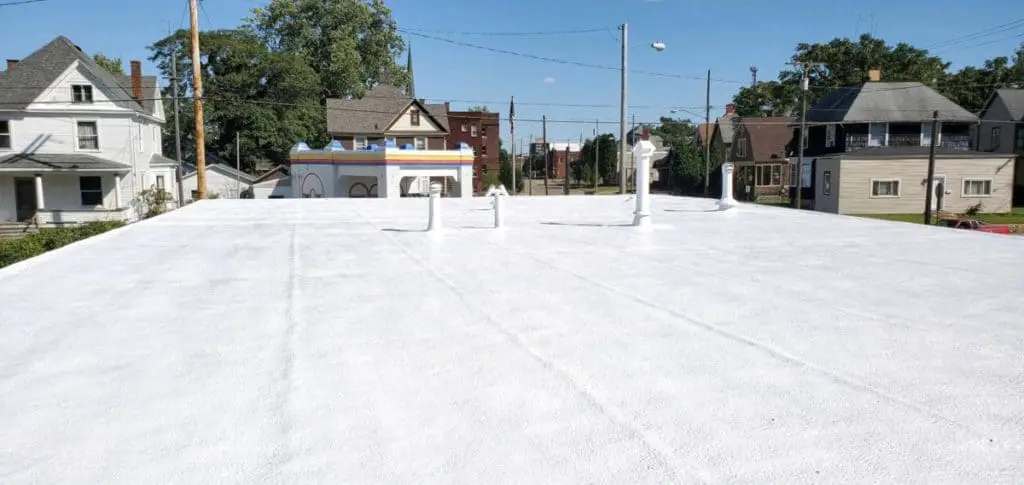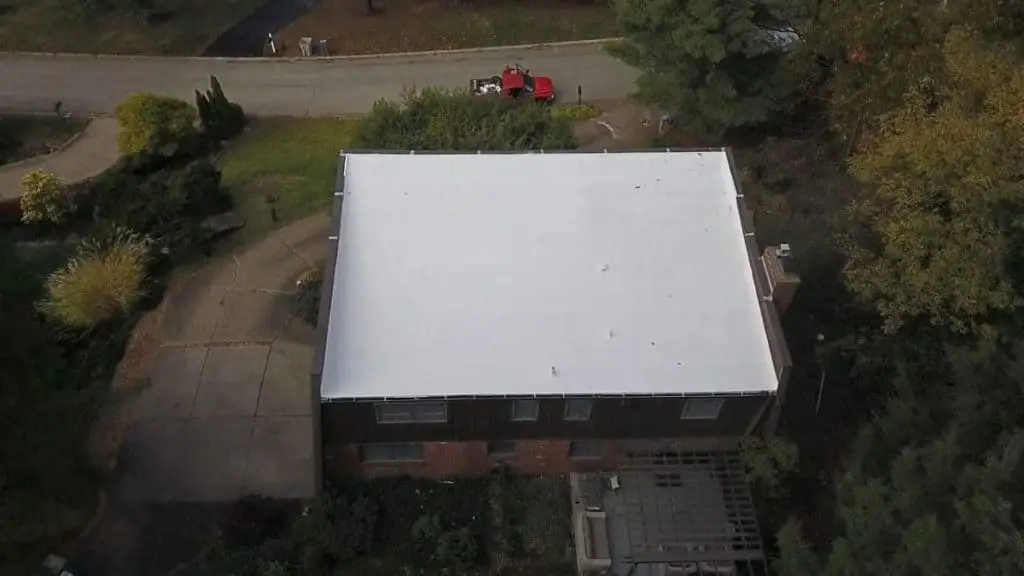
What is Spray Polyurethane Foam Roofing?
Spray Polyurethane Foam Roofing (SPF) is also known as Spray-On roofing because it involves spraying polyurethane foam and silicone to form a roof.
The roof system is made up of three different layers which are:
- Base Foam Coating
- Top Coating
- Granule Coating
The base foam coating provides insulation and protection to the roof. But is still vulnerable to UV rays and water. The second coating or the top coating is the silicone layer which protects the foam from weathering. Lastly, the granule coating is added to give additional protection against impact damages.
There are many more things to consider before deciding whether a Spray Polyurethane Foam is the best option for you.
Pros:

1.Wind Resistance:
SPF roof system has a strong resistance to wind. The wind uplift rating for it is about 160 lbs per square inch, making this a great option for high wind areas and large commercial buildings.
2.UV Resistance:
SPF roofs are resistant against UV radiation which adds to the durability of the roof. The UV resistance comes from the silicone layer which is added above the Polyurethane Foam.
3.Life Expectancy:
SPF roof system has a lifespan of about 10 to 20 years depending on how thick it is. A 20 mil coating will last 10 years, a 25 mil coating will last about 15 years and a 30 mil coating will last about 20 years. But with proper maintenance, an SPF roof can last a lifetime.
4.Easy Maintenance:
If an SPF roof is properly maintained then it can last 50+ years. An SPF roof needs regular maintenance every 10 – 20 years. Maintenance is only needed when the top silicone layer has worn down to about 8 mils or when there have been any impact damages.
It is best to have your SPF roof regularly inspected about every 2 years or after any storms where there may have been impact damages.
When there have been damages that occurred or when the silicone layer has weathered down to 8 mils. A new silicone coating needs to be sprayed on. This is not technically considered a reinstallation but as maintenance. This is because no new roof is being installed. Instead, the old roof stays and the silicone is simply just re-applied.
5.Versatility:
SPF foam roof can be applied to both residential and commercial roof buildings. However, it is most commonly used on industrial buildings.
6.Easy Installation:
SPF foam is very easy to install. It just involves using a hose to spray the foam chemical compound and silicone onto the roof. It’s quick and easy to spray the foam up walls and on or around pipes
8. Great Insulation:
Immediately after SPF foam is sprayed, it begins the curing process. As the foam cures, it forms gas-filled bubbles that float to the surface. Much like yeast rising in freshly baked bread. As the foam dries it traps the bubbles giving it a spongey foam texture. These trapped bubbles make for great insulation.
The SPF foam provides the highest R-value value per inch. Which helps you save money on energy costs required to heat and cool the building. It also helps to keep industrial cold storage units cold.
9. Seamless:
This is a big advantage that the SPF roof has over other low slope roof systems. An SPF roof does not have any seams to heat weld or seal. It’s a seamless system. The seams are often the most vulnerable points on other low slope roof systems like EPDM, TPO, and PVC.
10.Filler:
SPF roofs are sprayed on as a liquid which expands to a foam. This makes it perfect for filling in cracks, holes, and gaps that may exist on the roof. It also allows roofers to adjust the levels of the roof to reduce the chances of ponding.
11.Environmentally Ideal:
An SPF roof does waste a lot of materials. Usually when installed no previous roofing material needs to be removed. This saves labor costs and material waste. SPF roofs can also help reduce the urban heat island effect.
Cons:

1.Temperature:
The SPF roof can only be sprayed on during warm seasons. The minimum temperature needed to spray on the Polyurethane Foam is about 55°F or 13°C. If there is poor weather like rain or cold temperatures then the foam will not cure properly.
2.Impact Resistance:
Another disadvantage of Spray Polyurethane Foam is that it is not strong against impacts. SPF foam is rated to resist about 40 lbs per square inch. Which is quite a bit less than TPO and PVC. But at that rating, you will still be able to walk on the roof, it just won’t hold up as well in a hail storm or against things like bird-pecking.
The added surface layer of granules helps to give the roof more resistance to impact damages. So it’s important to make sure this feature is included in your new SPF roof if that’s the way you decide to go.
3.Price:
An SPF roof system is generally more expensive than the other low slope/flat roof systems. The price range for an SPF roof is about $400 – $700 per square (100 square feet in 1 square). But if you look at the cost per life expectancy the longer you own this type of roof the cheaper it becomes. You can compare SPF roof prices to other roofing material prices by clicking this link.
4.Messy Installation:
While SPF roofs are easy to install because it just involves spraying. One problem that naturally comes from spraying the insulation is overspray.
Overspray is when the foam flies over the edges of the roof or gets carried in the wind. This can cause the foam to land in unintended places. Extra precautions are taken to ensure that the foam doesn’t get sprayed where it shouldn’t. This may include things like:
- Covering parked cars near the building with covers.
- Using a cardboard or plastic protective shield along the edges of the roof.
5.Contractor Precautions:
In addition to protecting from overspray. The roofers doing the spraying need to be protected too. It is always best for them to wear protective dust masks and eyewear. (I wouldn’t want any fumes or expanding foam in my lungs or eyes.) They should also wear a protective jumpsuit or clothing and shoes that they don’t mind getting covered in foam.
6.Installed by Skilled Contractor:
An SPF roof must be installed by a skilled contractor. The best contractors know to take into consideration the moisture level, wind conditions, temperature, overspray, and more. It is important to hire a roofer that knows what they are doing.
Is it right for you?
A Spray Polyurethane Foam roof is not the best option for everyone. It all depends on what your individual circumstances are. To decide if this roof is the best for you you must evaluate the Pros vs the Cons to make that decision. There isn’t a one answer fits all solution here, if there is then it would be the words “it depends”. If you aren’t sure if the SPF roof system is right for your needs you can take a look at the other possible roofing options.
Alternative Options:
If a Spray-On Roof system doesn’t sound like the right kind of roof for you. There are at least 6 other options available for low slope/flat roofs. Below I have placed a nice little chart with links to other Pros & Cons lists for the other 6 low slope roofing options.
If you are interested in other roofing options I recommend you take a look at this article which I spent several months writing. It is a complete guide where I explain about 17 different types of roofing materials that are used today. You can read the article here.
This chart table shows the 6 other options for low slope roofs.
| Type | Description |
|---|---|
| FleeceBack roof | FleeceBack roof system is a Fleece material made out of polyester that can be added to the underside of EPDM, PVC, or TPO. It is adhered to the surface of the roof using 2-part fast adhesive foam. Click Here to Learn More about the FleeceBack roof system. |
| Built-Up Roof | Built-Up Roof (BUR) is made up of multiple layers alternating between fabric material and bitumen (asphalt). Finally, the last layer is topped with rocks or gravel. Click Here to Learn More about Built-Up Roof. |
| EPDM | EPDM stands for Ethylene Propylene Diene Terpolymer. It’s a rubber-based material. Click Here to Learn More about EPDM. |
| TPO | TPO stands for Thermoplastic Polyolefin. This is a single-ply flat roof system that the newest of all the flat roof systems. Click Here to Learn More about TPO. |
| PVC | PVC stands for Polyvinyl Chloride and is made up of ethylene and chlorine which are derived from processed petroleum or natural gas and salt respectively. Click Here to Learn More about PVC. |
| Modified Bitumen | Modified Bitumen is a 2-part flat roof system. It was developed in Europe around the 1960s. It comes in two different types. Click Here to Learn More about Modified Bitumen. |
Related Questions:
Can you walk on a foam roof? You can walk on a foam roof. A foam roof is made to support 40 lbs per square inch, so you can walk on it. But if you were to drop a pointy or sharp object on it then it would put a hole in it.
Can I spray foam my roof? It is strongly recommended to hire a professional roofer that is experienced with SPF roofing to spray foam your roof. There are many things that need to be considered before spraying foam on your roof like:
- Moisture levels
- Temperature
- Wind Conditions
- Toxic Fumes
- and more
